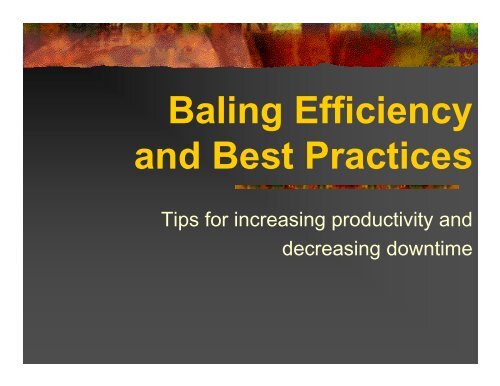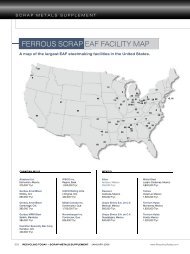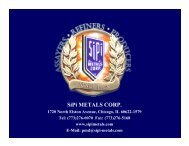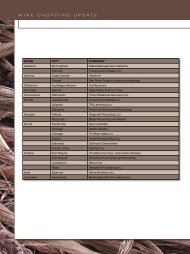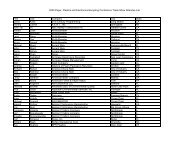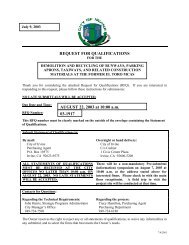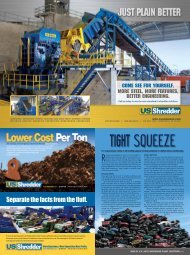Baling Efficiency and Best Practices - Recycling Today
Baling Efficiency and Best Practices - Recycling Today
Baling Efficiency and Best Practices - Recycling Today
Create successful ePaper yourself
Turn your PDF publications into a flip-book with our unique Google optimized e-Paper software.
<strong>Baling</strong> <strong>Efficiency</strong><strong>and</strong> <strong>Best</strong> <strong>Practices</strong>Tips for increasing productivity <strong>and</strong>decreasing downtime
Maximum Performance Through• Baler Choice• Bale Density• Bale Integrity• Operator Productivity• Maintenance <strong>and</strong> Housekeeping
Bale Density <strong>and</strong> IntegrityAchieving Proper BaleDensity <strong>and</strong> IntegrityFor bale density <strong>and</strong> integrity you firsthave to look at what type of materialyou are going to process. Differenttypes of material have their ownunique properties.
Bale Density <strong>and</strong> Integrity - PaperCommon paper products recycled•OCC•CPO•CBS•SWL•ONP•OMG•White Office Paper
Bale Density <strong>and</strong> Integrity - PaperChallenges of recycling paperSince many types of paper will cometo the recycler in a tight package,preconditioning is necessary to ensuregood bales. Two pieces of equipmentused to precondition paper areFluffers <strong>and</strong> Shredders.
Bale Density <strong>and</strong> Integrity - PaperFluffers(also known as conditioners, rufflersor distributors) will pull the paperapart <strong>and</strong> fluff it up.
Bale Density <strong>and</strong> Integrity - PaperShredders• Will shred tightly-packed paper• Can increase baling production speed• Can create very tight bales• Create short fibers
Bale Density <strong>and</strong> Integrity - PaperTwo challenges when baling OCC• It comes in many different sizes.• It has a lot of memory when baled dry.
Bale Density <strong>and</strong> Integrity - PaperH<strong>and</strong>ling varied OCC sizes• Large infeed opening on baler• Precondition large pieces• Shredder• Precrusher flaps• Tramper
Bale Density <strong>and</strong> Integrity - PaperH<strong>and</strong>ling OCC memory• Very dry bales are not as dense• A small amount of moisture will reducethe memory
Bale Density <strong>and</strong> Integrity - PlasticCommon plastic products recycled• HDPE• PET• E-WASTE• PVC• LDPE
Bale Density <strong>and</strong> Integrity - PlasticChallenges of <strong>Recycling</strong> PlasticThe main challenge of baling plasticis air trapped in bottles, which canlead to lower bale density <strong>and</strong>integrity as well as increased balingtimes. Two solutions for this problemare pre-crushing bottles in acompactor <strong>and</strong> perforating bottles toallow air to escape.
Bale Density <strong>and</strong> Integrity - PlasticPre-crush bottles in a compactor• Removes most of the air, allowing morebottles to be stored in a bunker• Reduces the time it takes to make a bale• Creates tighter bales
Bale Density <strong>and</strong> Integrity - PlasticPerforate HDPE <strong>and</strong> PET• Allows air to escape from bottles• Allows baler to process bottles faster• Integrity of the bale will be tighter
Baler ChoiceChoosing a Baler ForYour MRFThere are many types of balers on themarket today. Choosing the rightequipment for your MRF can be a realchallenge.
Baler ChoiceChoosing a Baler•What size MRF is being considered?•What is the throughput of the MRF?•What is the projected growth of the MRF?•What will be the material flow?
Baler ChoiceClosed-End Balers <strong>and</strong> Downstrokes•Pros•Cons• Lower initial investment• Smaller area needed to process material• More labor-intensive• Equipment will need to be upgraded with growth• Bales are strapped by h<strong>and</strong>
Baler ChoiceOpen End Auto-Tie•Pros• Fits in a smaller designed area• Works very well for an inline system flow control• Makes all ties on a bale at the same time• Designed for fast paper <strong>and</strong> plastic operation• Two process to make a bale (compaction <strong>and</strong> tying)•Cons• Infeed hoppers somewhat small• Large materials require some preprocessing• Requires 10 or more spools of tie wire• Some do not have shear blades• Not the best for light metals
Baler ChoiceTwo Ram Auto-Tie Balers•Pros•Cons• Capable of shearing material if necessary• Uses only one spool of tie wire at a time• Has a large infeed hopper• Can have a larger compaction cylinder• In a multi-material operation, it has the option of aseparation door to eliminate material cross contamination• Capable of being fed over the side with a loader• When baling plastics, preprocessing works better forbale integrity• Has a large footprint• Will always eject bale at right angle to baler• Has three processes to make a bale (compaction, ejection <strong>and</strong> tying)
Operator Do’s <strong>and</strong> Don’ts - SafetySafe Operators Increase <strong>Efficiency</strong>The consequences of poor safety practices include injury, downtime,repairs, <strong>and</strong> more.
Operator Do’s <strong>and</strong> Don’ts - Safety• Do’s• Always walk around <strong>and</strong> inspect your equipment before turning it on• Inspect again after starting equipment• Make sure all alarms are in good working order• Always wear the proper protective gear• Don’ts• Never go inside the baler chamber orhopper while baler is running• Never ever st<strong>and</strong> or walk on a conveyorwhile the baler is running• Never enter the baling chamber orhopper improperlyThe proper way to enter the balingchamber or hopper is to:1. Make sure no material can fall offconveyor2. Push the Emergency Stop (E-Stop)button in3. Turn the key switch off4. Turn the Main disconnect off5. Lock <strong>and</strong> tag the Main disconnect6. Manually activate all hydraulicsolenoid valves
Operator Do’s <strong>and</strong> Don’tsProductivity <strong>and</strong> avoidingcatastrophic failuresWhether the equipment is operated manually orautomatically the operator is responsible forwhat happens during the operation. It is their jobto make sure nothing enters the baler that it wasnot designed to h<strong>and</strong>le.
Operator Do’s <strong>and</strong> Don’tsProductivity <strong>and</strong> avoiding catastrophic failures•Make sure nothing enters the baler that it was not designed to h<strong>and</strong>le•Feed material at a steady <strong>and</strong> even rate•Precondition materials, when necessary•Maintain the baler <strong>and</strong> operate it inside recommended parametersYou can’t t bale engine blocks, I-beams, Iblocks of metal, 24” trees <strong>and</strong> concretebecause they are as dense as they are evergoing to get. And you can’t t bale Jellobecause you can’t t put a tie on it.
Operators Do’s <strong>and</strong> Don’tHousekeepingCleanliness <strong>and</strong> MaintenanceKeeping the facility clean is more important than just sweeping the floor.Keeping the area around the equipment clean <strong>and</strong> free of obstacles is asafety matter as well.
HousekeepingWhen <strong>Baling</strong> Light Metals•Sharp metals can cause personal injury•Long extrusions are a tripping hazard•Thin metal under platens cancause damaged cylinder seals•Metal stuck in conveyor tracks,chain, head stock, tail stock,wings <strong>and</strong> drive chains canresult in major repair costs
HousekeepingWhen <strong>Baling</strong> Paper Products•Paper on floor is a slipping hazard.•Paper in conveyor tracks, chain, head stock, tail stock, wings <strong>and</strong> drivechains can result in major repair costs.•Paper under platens can cause damaged cylinder seals, hydrauliccylinders, any pivot points <strong>and</strong> fire hazard.•Paper laying around <strong>and</strong> on hydraulic units that have oil on them canraise the operating oil temperature as much a 40º F, causing parts to wearvery fast.•Cleaning off the operator’s panel will help reduce push buttons fromseizing up. It will also help the visibility of the readout.
Maintenance At What Cost• Importance of maintaining equipment• Maintenance Programs – Pros & Cons• The need to incorporate a maintenancebudget in the planning stages of a MRF
Maintenance At What CostImportance of maintaining equipmentPreventive maintenance (PM’s) normally consists of cleaning, checkingoil, repairing leaks, replacing worn parts <strong>and</strong> monitoring for properoperation. PM’s are performed on regular intervals based on equipmentworking hours.Most companies underst<strong>and</strong> that rolling stock, including fork-trucks, tractortrailers, front end loaders <strong>and</strong> other vehicles, require service on a regularbasis. However, a maintenance program should be established for theentire facility including all stationary <strong>and</strong> mobile equipment.Material Recovery Facility equipment, such as conveyors, balers, sortingequipment, etc., equally require routine maintenance to decrease downtime <strong>and</strong> increase productivity.
Maintenance At What CostImportance of maintaining equipment
Maintenance At What CostImportance of maintaining equipment
Maintenance At What CostMaintenance Programs – Pros & ConsPros• Longer equipment life• Scheduled down timeverses unscheduled /emergency down time• Increases long termproduction• Able to identify <strong>and</strong> resolvemalfunctions before majordamage is causedCons• Considered an increase inbudgeted Operating Costs• Requires trained permanentemployee or contracted service• Requires purchasing parts forstock• Downtime required to performpreventive maintenance on adaily, weekly, monthly orquarterly basis
Maintenance At What Cost• The need to incorporate a maintenancebudget in the planning stages of a MRFMost of the budgeted costs <strong>and</strong> time for service <strong>and</strong> preventivemaintenance are allocated for rolling stock, leaving little or no fundsto perform preventive maintenance <strong>and</strong> service on other facilityequipment. However, emergency repair costs of MRF equipmentcan greatly exceed a budgeted preventive maintenance program.When preparing a budget for a MRF first consider an adequatemaintenance program. Programs are readily available from mostequipment manufactures, several publications <strong>and</strong> the internet. Byusing a good program along with precise documentation many ofthe unforeseen repair costs can be avoided.
Question & AnswerFeel free to ask questions….Buddy HimesHimes Service Company, Inc.Waco, Texas USA


